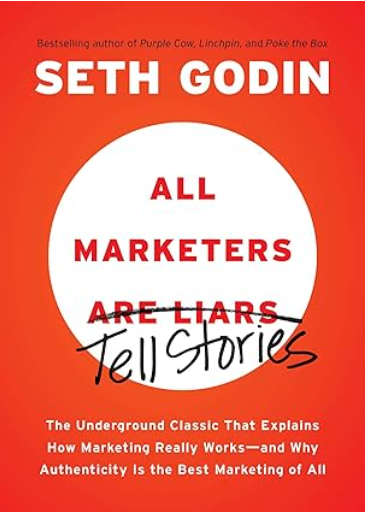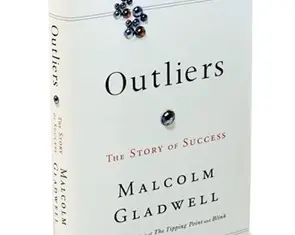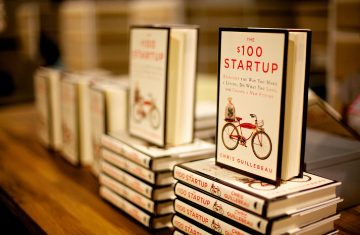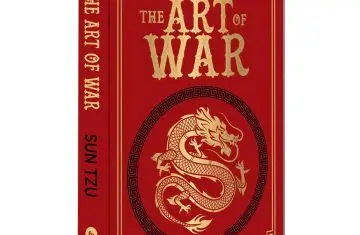Marketing is no longer about the stuff you make, but about the stories you tell.
All marketers are storytellers. Only the bad ones are liars.
The best stories don’t teach people anything new. They let them see what they already believe.

When you hear the title All Marketers Are Liars, you might think Seth Godin is accusing marketers of cheating people. But as you go deeper, you realize – he’s talking about something bigger. He’s talking about how humans have always connected through stories. From the time of cave paintings to your favorite Netflix series, we’ve been drawn to stories that match our beliefs, values, and dreams.

The book starts with this simple idea: people don’t buy products – they buy the stories those products tell. Imagine two cups of coffee. One is in a random paper cup from a street stall. The other is in a fancy Starbucks cup with your name handwritten on it. The coffee might taste almost the same – but the story around Starbucks makes you feel like you’re part of something more. That’s the power of storytelling.
Godin says marketing today is less about shouting “Buy my product!” and more about making people feel something – hope, pride, belonging, even nostalgia. The trick isn’t to invent lies. Instead, you tell a story so true and emotionally strong that your audience sees themselves in it.
He explains how great marketers tap into what their audience already believes. If people think handmade products are better, you don’t argue – you show them your handmade product in a way that reinforces that belief. If your audience loves the idea of “eco-friendly,” you don’t just give them stats – you wrap your product in a green, natural, and authentic story.

But Seth also warns – when marketers fake a story and can’t deliver on it, the truth comes out. In today’s connected world, one unhappy customer can expose a lie in seconds. So the story must match the reality. The brand and the product have to live up to the promise.

He shares examples of brands that succeeded because of authentic storytelling – Apple selling not just devices but creativity and rebellion; luxury brands selling not just handbags but status and identity. And he also shows the failures – companies that told a fake story and got caught, losing all trust.
The deeper message is – storytelling is not only for selling products. Every person, every group, every movement tells a story. Your social media posts tell a story about you. The way you speak in an interview tells a story about your values. And in a noisy world, the story that feels most real is the one that wins.
What Youth Can Take Away from This
Bangladeshi youth are stepping into a world that’s more competitive and fast-changing than ever. Many young people here want to start businesses, create content, or build personal brands – but they often make the same mistake: they focus only on the “thing” they’re selling, not the story behind it.
For example:
- A young entrepreneur launches a clothing brand but only talks about the fabric and price, not the inspiration or identity behind the clothes.
- A YouTuber uploads videos with no clear theme or personality – just random content – so viewers don’t feel a connection.
These mistakes happen because we think facts alone will convince people. But as Seth Godin reminds us – people decide with their emotions first, then justify with logic.
Here’s how the book’s takeaway can change that:
- Tell the “why” before the “what.” If you sell handmade jewelry, don’t start by saying, “It’s silver and 200 taka.” Tell me, “This piece is inspired by my grandmother’s village design – every swirl is hand-shaped.”
- Make your audience the hero. If you run an eco-friendly brand, make customers feel like they’re joining a bigger mission, not just buying a product.
- Be consistent. Your story should match your actions. If you say “eco-friendly,” your packaging, materials, and even your online presence should reflect it.
One relatable example:
A group of Dhaka University students once started a small tea stall in front of campus. Instead of just selling tea, they told a story – they called it “Adda Cha,” a place where students could share ideas and debates over a cup of tea. They shared photos of friends laughing, scribbling notes, and discussing big dreams. The tea itself wasn’t anything special, but the story made it the place to be. That’s storytelling in action.
Another example:
A Chattogram-based girl started selling Shidol Shutki online. At first, she posted plain photos and got little attention. Then she began telling stories about her family’s fishing tradition, the smell of fresh sea wind, and how every order supports local fishermen. Within months, her page became a small community of loyal customers.
These stories work because they feel real and relatable.
The beauty of Seth Godin’s message is – it’s not just for business. Even if you’re applying for a job or joining a social project, your personal “story” matters. Instead of saying, “I’m a hard worker,” show how you turned a challenge into success. Instead of saying, “I’m creative,” share a moment where your creativity solved a real problem.
In Bangladesh, where so many young voices are competing to be heard, your story can be your edge. You don’t need to fake it – you need to find the truth that makes you unique and tell it in a way that connects with people’s hearts.
And here’s the hopeful part – you don’t need a huge budget or fancy equipment to start. You can begin today. Whether it’s on your Instagram captions, your pitch to a client, or the way you describe your student club – practice telling stories that are authentic, emotional, and consistent.
Start small. Tell one honest, powerful story about what you do and why it matters. And let it grow. Because in a world full of noise, the truest stories still travel the farthest.
Who is Seth Godin?

Seth Godin is one of the most influential voices in marketing and creativity today. He’s not just a “business guru” – he’s a storyteller himself. Over the years, Seth has written many bestselling books like Purple Cow, Tribes, and The Dip. His style is short, punchy, and thought-provoking – he likes to strip away complicated business talk and get to the human side of marketing. He’s also known for inspiring ordinary people to think differently about how they present themselves and their ideas to the world.
Thank for giving me your time while reading this. Getting anyone’s time is the most precious thing for me. To read my other blogs like Building Social Business by Yunus | A book summary for youth, Phobia to Nervous moment? Is it normal?, and The Shondha River Stole My Childhood: Why I’m Fighting Climate Anxiety, you can click here.





